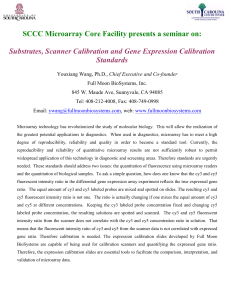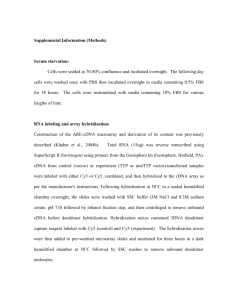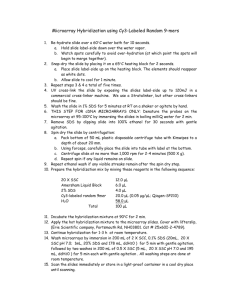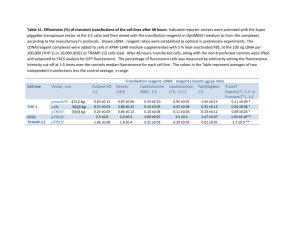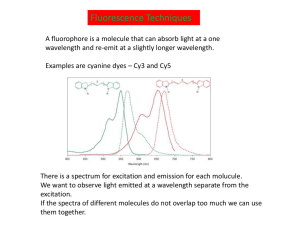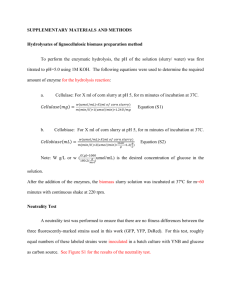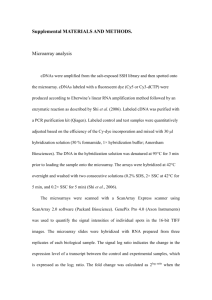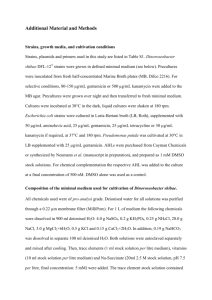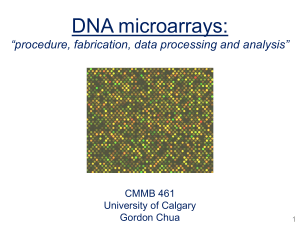Dirigent protein-like genes expression in response to mechanical
advertisement
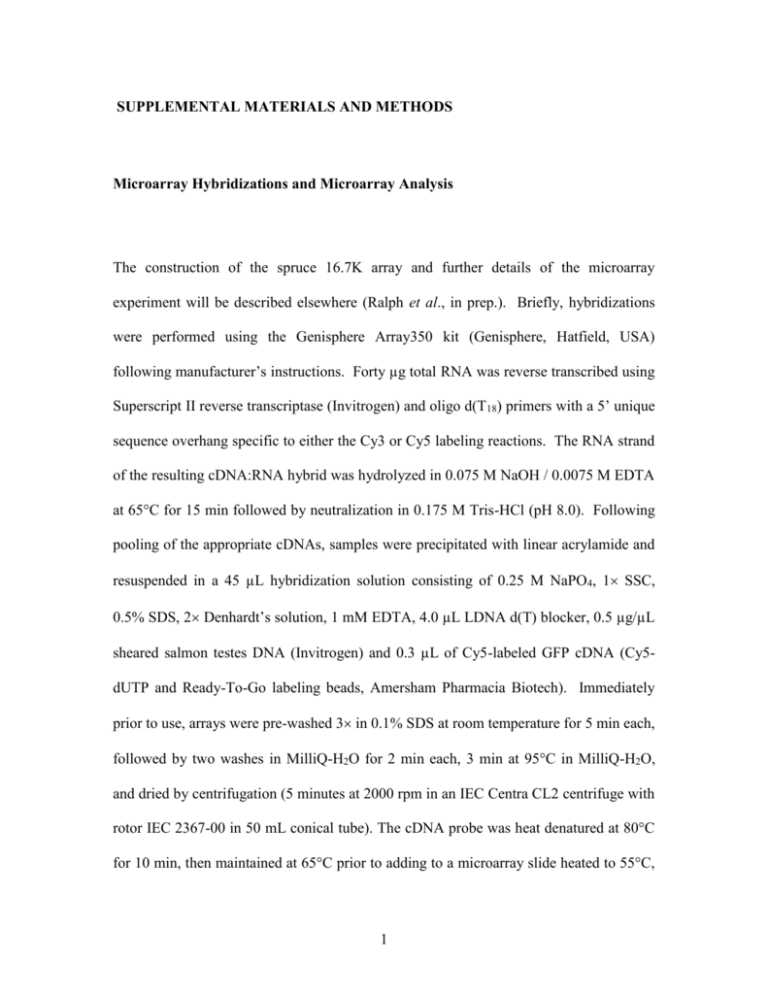
SUPPLEMENTAL MATERIALS AND METHODS Microarray Hybridizations and Microarray Analysis The construction of the spruce 16.7K array and further details of the microarray experiment will be described elsewhere (Ralph et al., in prep.). Briefly, hybridizations were performed using the Genisphere Array350 kit (Genisphere, Hatfield, USA) following manufacturer’s instructions. Forty µg total RNA was reverse transcribed using Superscript II reverse transcriptase (Invitrogen) and oligo d(T18) primers with a 5’ unique sequence overhang specific to either the Cy3 or Cy5 labeling reactions. The RNA strand of the resulting cDNA:RNA hybrid was hydrolyzed in 0.075 M NaOH / 0.0075 M EDTA at 65°C for 15 min followed by neutralization in 0.175 M Tris-HCl (pH 8.0). Following pooling of the appropriate cDNAs, samples were precipitated with linear acrylamide and resuspended in a 45 µL hybridization solution consisting of 0.25 M NaPO4, 1 SSC, 0.5% SDS, 2 Denhardt’s solution, 1 mM EDTA, 4.0 µL LDNA d(T) blocker, 0.5 µg/µL sheared salmon testes DNA (Invitrogen) and 0.3 µL of Cy5-labeled GFP cDNA (Cy5dUTP and Ready-To-Go labeling beads, Amersham Pharmacia Biotech). Immediately prior to use, arrays were pre-washed 3 in 0.1% SDS at room temperature for 5 min each, followed by two washes in MilliQ-H2O for 2 min each, 3 min at 95°C in MilliQ-H2O, and dried by centrifugation (5 minutes at 2000 rpm in an IEC Centra CL2 centrifuge with rotor IEC 2367-00 in 50 mL conical tube). The cDNA probe was heat denatured at 80°C for 10 min, then maintained at 65°C prior to adding to a microarray slide heated to 55°C, 1 covered with a 22 60 1.5 mm glass coverslip (Fisher Scientific), and incubated for 16 h at 60°C. Arrays were washed in 2 SSC, 0.2% SDS at room temperature for 5 min to remove the coverslip, followed by 15 min at 65°C in the same solution, then three washes of 5 min in 2 SSC at room temperature, and three washes of 5 min in 0.2 SSC at room temperature, and dried by centrifugation. The Cy3 and Cy5 3DNA capture reagent (Genisphere) were then hybridized to the bound cDNA on the microarray in a 45 µL volume consisting of 0.25 M NaPO4, 1 SSC, 0.5% SDS, 2 Denhardt’s solution, 1 mM EDTA, 2.5 µL Cy3 capture reagent and 2.5 µL Cy5 capture reagent. The 3DNA capture reagent is bound to its complementary cDNA capture sequence on the Cy3 or Cy5 oligo d(T) primers. The second hybridization was performed for 3 h at 60°C, then washed and dried as before. Fluorescent images of hybridized arrays were acquired by using ScanArray Express (Perkin Elmer, Foster City, USA). The Cy3 and Cy5 cyanine fluors were excited at 543 nm and 633 nm, respectively. All scans were performed at the same laser power (90%), but with the photomultiplier tube settings for the two channels adjusted such that the ratio of the mean signal intensities was ~1, and the percentage of saturated array elements was < 0.5% but > 0%, while minimizing background fluorescence. Fluorescent intensity data were extracted by using the ImaGene 5.5 software (Biodiscovery, El Segundo, USA). Before normalization, the lowest 10% of median foreground intensities was subtracted from the median foreground intensities to correct for background intensity. After quantification of the signal intensities, data were normalized to compensate for nonlinearity of intensity distributions using the vsn method (Huber et al., 2002). A linear model was applied to obtain a single estimate and standard error of the ΔH difference 2 statistic of expression for each parameter examined (i.e. mechanical wounding versus untreated control at 2 h) (Smyth, 2004). The ratio of the estimate to the standard error was used to calculate a t statistic, from which a P value was obtained. 3 Supplemental Table V. Gymnosperm and angiosperm DIR and DIR-like genes represented in phylogenetic analyses. Species Gymnosperms Picea glauca (white spruce) Picea sitchensis (Sitka spruce) Picea glauca x engelmannii (interior spruce) Tsuga heterophylla (western hemlock) Thuja plicata (western red cedar) Angiosperms Arabidopsis thaliana (thale cress) Oryza sativa (Japonica) (rice) DIR Nomenclature FLcDNA Accession Number Genomic ORF Accession/AGI Number PDIR1 PDIR7 PDIR10 PDIR12 PDIR18 PDIR11 PDIR15 PDIR16 PDIR17 PDIR19 PDIR2 PDIR3 PDIR4 PDIR5 PDIR6 PDIR8 PDIR9 PDIR13 PDIR14 ThDIR1 ThDIR2 TpDIR1 TpDIR2 TpDIR3 TpDIR4 TpDIR5 TpDIR6 TpDIR7 TpDIR8 TpDIR9 DQ395241 DQ395247 DQ395250 DQ395252 DQ395258 DQ395251 DQ395255 DQ395256 DQ395257 DQ395259 DQ395242 DQ395243 DQ395244 DQ395245 DQ395246 DQ395248 DQ395249 DQ395253 DQ395254 AF210071 AF210072 AF210063 AF210064 AF210065 AF210066 AF210067 AF210068 AF210069 AF210070 AF487405 n.a. n.a. n.a. n.a. n.a. n.a. n.a. n.a. n.a. n.a. n.a. n.a. n.a. n.a. n.a. n.a. n.a. n.a. n.a. n.a. n.a. n.a. n.a. n.a. n.a. n.a. n.a. n.a. n.a. n.a. AtDIR1 AtDIR2 AtDIR3 AtDIR4 AtDIR5 AtDIR6 AtDIR7 AtDIR8 AtDIR9 AtDIR10 AtDIR11 AtDIR12 AtDIR13 AtDIR14 AtDIR15 AtDIR16 AtDIR17 AtDIR18 AtDIR19 AtDIR20 AtDIR21 AtDIR22 AtDIR23 AtDIR24 AtDIR25 OsDIR1 OsDIR2 OsDIR3 OsDIR4 OsDIR5 OsDIR6 OsDIR7 OsDIR8 OsDIR9 OsDIR10 OsDIR11 OsDIR12 OsDIR13 n.a. AY093095 n.a. n.a. AK175255 BT002439 AK118030 n.a. BT010722 BT002889 AK176442 BT004016 BT009718 n.a. CNS0A3JZ BT008336 n.a. AY081267 AK117899 AY128336 n.a. BT015420 BT005788 CNS0A5KQ n.a. AK109288 n.a. AK065027 AK108186 AK108922 n.a. n.a. n.a. AK108101 n.a. AK106022 n.a. n.a. At5g42510 At5g42500 At5g49040 At2g21110 At1g64160 At4g23690 At3g13650 At3g13662 At2g39430 At2g28670 At1g22900 At4g11180 At4g11190 At4g11210 At4g38700 At3g24020 CAB67637 At4g13580 At1g58170 At1g55210 At1g65870 At3g13660 At2g21100 At3g55230 At1g07730 NM_186138 NM_186143 AP006186 XM_482075 NM_196355 NM_189817 NM_189810 NM_184035 NM_194246 NM_184603 XM_479255 XM_479260 XM_479267 4 Hordeum vulgare (barley) Triticum aestivum (wheat) Saccharum officinarum (sugarcane) Pisum sativum (pea) Forsythia intermedia (shrub) Podophyllum peltatum (mayapple) Sorghum bicolor (sorghum) Gossypium barbadense (cotton) Zea mays (corn) OsDIR14 OsDIR15 OsDIR16 OsDIR17 OsDIR18 OsDIR19 OsDIR20 OsDIR21 OsDIR22 OsDIR23 OsDIR24 OsDIR25 OsDIR26 OsDIR27 OsDIR28 OsDIR29 OsDIR30 HvDIR1 HvDIR2 HvDIR3 TaDIR1 TaDIR2 TaDIR3 SoDIR1 SoDIR2 SoDIR3 PsDIR1 PsDIR2 FiDIR1 FiDIR2 PpDIR1 SbDIR1 GbDIR1 ZmDIR1 n.a. AK108983 n.a. n.a. n.a. AK121408 n.a. n.a. n.a. n.a. n.a. n.a. n.a. n.a. n.a. n.a. n.a. U43497 U43496 AF021258 U32427 AF483596 AB012103 AY421731 AJ626722 AY781903 AF115574 U11716 AF210061 AF210062 AF352736 AF527807 AY560544 AF232008 5 NM_188847 XM_479273 XM_479258 NM_195796 XM_450817 AC135595 AC119796 NM_184427 AP003856 NM_196360 AP003369 NM_195790 NM_195802 XM_481885 XM_481843 XM_481834 XM_481890 n.a. n.a. n.a. n.a. n.a. n.a. n.a. n.a. n.a. n.a. n.a. n.a. n.a. n.a. n.a. n.a. n.a. Supplemental Table VI. Oligonucleotides used in real-time PCR. Isoform PDir2 Primer name Dir2F Dir2R PDir5 Dir5F Dir5R PDir6 Dir6F Dir6R PDir8 Dir8F Dir8R PDir13 Dir14F Dir14R PDir19 Dir15F Dir15R PDir1 Dir1F Dir1R Dir10F PDir10 Dir10R Dir16F PDir12 Dir16R ActinF ß-Actin ActinR 1 Primer position from stop codon. Sequence 5’-TGTTTCATTCTCATGCAGATTTG-3’ 5’-TTATTTCACTCTACGCTAGCTG-3’ 5’-TCCTTCTGCTCTCCATTTCTATG-3’ 5’-CATTATTTCACTGCACGCTACAG-3’ 5’-CTTTTGCAAATCTGCATTGGTAG-3’ 5’-TTCAATCAATCATGTGAGGAGC-3’ 5’-GCGTGCAGTGAAATAATGTCTAC-3’ 5’-GAGAACGATTCTGACAAAATCTC-3’ 5’-ACTGCTTATCACATGAGTTGCG-3’ 5’-GGACCTTCATGGAGATCCCTC-3’ 5’-TCTGCCACCGTAAGCAAGGACC-3’ 5’-GATGAGCATAGCTCCACACAAATC-3’ 5’-GCTGTGGGTAGGTATTCTGATC-3’ 5’-TATGCACAGAAGACACGGCCATG-3’ 5’-TGCCCGGCAGTGGTATATACATTG-3’ 5’-GCAAGCAGCATTGGATACTGTCAC-3’ 5’-TGTAGAGGTGAAATCAAGGCTCAGTC-3’ 5’-TGGTCATGATTAGACTACCCTTTG-3’ 5’-GGTATCCATGAGACTACATAC-3’ 5’-CAGGAAACATGGTAGAACCAC-3’ 6 Description1 +93 to +116 +142 to +164 +30 to +52 +104 to +127 +101 to +124 +190 to +213 +88 to +111 +182 to +205 +12 to +34 +104 to +125 +1 to +23 +74 to +95 +70 to +91 +136 to +158 +46 to + 69 +119 to +142 +79 to +103 +161 to +184
